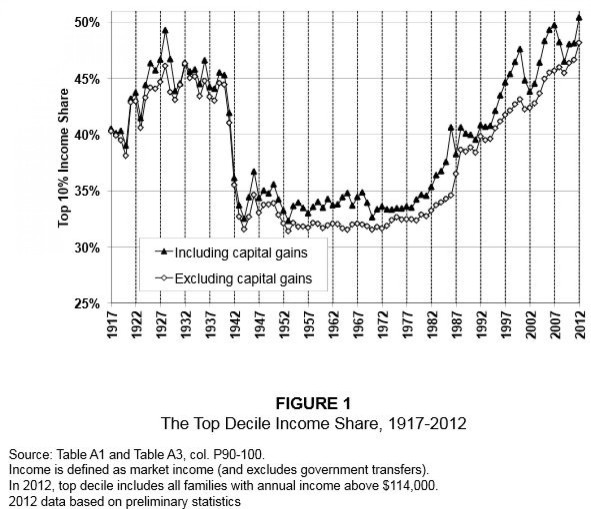US Income Inequality At Record High: Top 1% Earned A Fifth Of Total Income In 2012

The U.S. has long been viewed as the “land of opportunity,” where those who work hard get ahead. But the ever-widening wealth gap is putting the American dream out of reach for many. The gulf between the top 1 percent earner and the rest of the country grew to its widest level in history last year.
The top 1 percent earned one-fifth of the country’s household income last year – breaking the previous record set in 1928, the year before the historic stock market crash, according to an analysis by UC Berkeley’s Emmanuel Saez and the Paris School of Economics’ Thomas Piketty. The top 1 percent is defined as households with incomes above $394,000 in 2012.
The rich were hit hard by the Great Recession, but they’ve almost fully recovered. From 2009 to 2012, income for the top 1 percent of earners grew by 31.4 percent, while the bottom 99 (or everyone else) saw income rise by only 0.4 percent. Hence, the top 1 percent captured 95 percent of the income gains in the first three years of the recovery. “In sum, top 1 percent incomes are close to full recovery while bottom 99 percent incomes have hardly started to recover,” the authors wrote.

A booming stock market and rising home values have helped the most affluent Americans recoup their losses during the recovery era. The richest 10 percent of families – those with earnings exceeding $114,000 a year -- received half of all income in 2012. The income of the rest is still suppressed by high rates of unemployment and stagnant wages.
“These results suggest that the Great Recession has only depressed top income shares temporarily and will not undo any of the dramatic increase in top income shares that has taken place since the 1970s,” Piketty and Saez concluded.

The economy is still depressed for most wage-earners. The August jobs report showed that the share of Americans who are either working or looking for work fell to its lowest level since 1978. With sustained, relatively high rates of unemployment, businesses are under no pressure to raise their employees’ income.
A separate study found that areas with large middle classes enjoy far more economic mobility than areas with small middle classes. Climbing the income ladder occurs less often in the Southeast and industrial Midwest, the data shows, with the odds notably low in Atlanta, Charlotte, Memphis, Raleigh, Indianapolis, Cincinnati and Columbus. By contrast, some of the highest rates occur in the Northeast, Great Plains and West, including in New York, Boston, Salt Lake City, Pittsburgh, Seattle and large swaths of California and Minnesota.
© Copyright IBTimes 2024. All rights reserved.






















